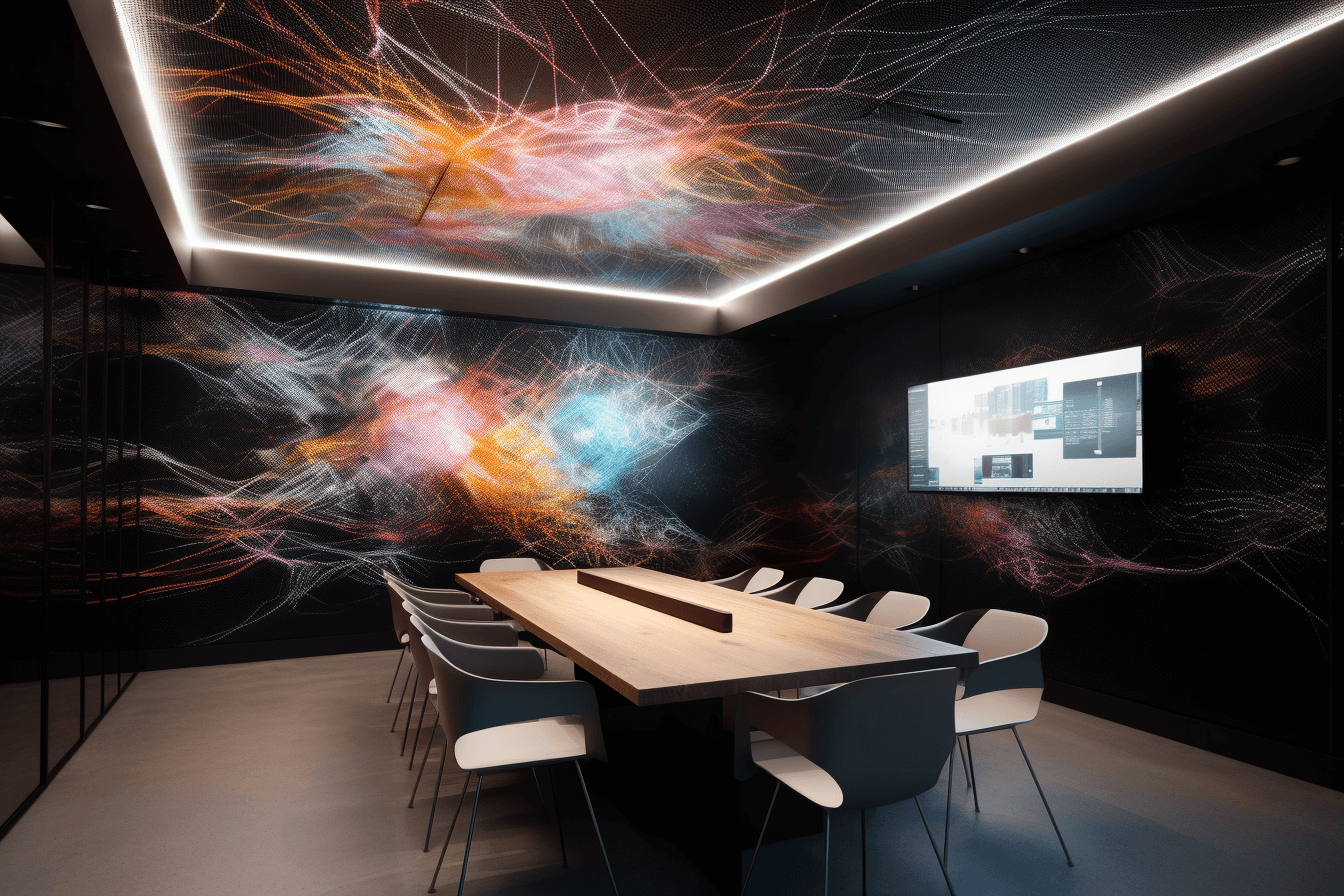Computational services in generative art unlock possibilities like AI art with neural networks, real-time interactive graphics, 2D/3D rendering, and complex algorithm development for captivating visual experiences.

Equipped with expertise in computational methods and generative art, our team can provide innovative and cutting-edge solutions for any project, helping to bring your artistic vision to life in ways you never thought possible.
Introduction
Computational services in generative art exhibitions use advanced technology and methods to create ever-evolving art with algorithms that respond to various inputs or data sets. By integrating real-world data, generative art visualizes complex information artistically. The possibilities are vast, from 2D and 3D renders to AI-generated artwork. Our team excels in neural networks, complex algorithms, and high-quality rendering, enabling organizations and artists to transcend traditional art and offer immersive, interactive experiences for audiences.
Data integration
Real-life data can be used for generative art by integrating it as an input source for algorithms, allowing the artwork to be influenced by real-time events or datasets. This can result in unique and constantly evolving pieces of art.
Our computational services team has the expertise to find solutions to connect data providers with generative art. We can work with a wide range of data sources and formats, providing potential clients with flexibility and versatility for their generative art projects. Some examples of the types of data sources and formats we can work with include:
- Public and private APIs: We can connect to various APIs, such as weather, financial market data, social media, or any other data provider offering an API to access their data.
- Databases: We can work with different databases, such as SQL, NoSQL, or graph databases, to extract and process data for generative art projects.
- CSV, JSON, XML, and other file formats: We can process data stored in common file formats like CSV, JSON, or XML, allowing for a seamless integration of data from diverse sources.
- Web scraping: We can extract data from websites through web scraping techniques, which can then be used as input for generative art algorithms.
- Real-time data streams: We have the ability to work with real-time data streams, such as IoT sensors, social media feeds, or any other data source providing a continuous flow of information.
By understanding the data structure and format, our team can develop custom algorithms that can ingest and interpret the data in real-time. This allows us to create generative art that is responsive to the data inputs, resulting in innovative and engaging visualizations that captivate audiences and showcase the potential of data-driven art.
AI Art
Creating AI Art installations for interior and exterior spaces demands specialized hardware and development expertise. Our team possesses the necessary tools and experience to craft unique AI Art installations that transcend traditional art forms.
We have experience with various AI techniques and technologies, such as Generative Adversarial Networks (GANs), StyleGAN, DeepArt, and more. These cutting-edge technologies empower us to produce visually stunning and thought-provoking AI Art, showcasing the creative potential of artificial intelligence.
We provide powerful computing hardware to handle complex AI Art computations, combined with our development expertise in AI, machine learning, and generative art to create installations that harmoniously blend technology and art. Our commitment to staying updated on the latest AI and generative art advancements ensures your AI Art installations will be innovative, engaging, and offer a unique experience for your audience.
Real-time interaction
Real-time interactive installations in interior and exterior exhibition spaces require robust hardware capable of handling the processing demands of generative art and interactive elements. We supply the necessary equipment, such as high-performance computers, to guarantee smooth and issue-free installations. Our team of experts is proficient in configuring and setting up hardware for optimal performance and reliability. Combining our hardware and software expertise, we assist in creating unique and immersive experiences for your audience, leaving a lasting impression.
Rendering
Rendering for prints, screens, and projections for generative art exhibitions requires specialized hardware and development capabilities to achieve high-quality output. Our team of experts has the necessary hardware and software tools to create beautiful, high-resolution prints and projections that showcase the intricate details of generative art.
Our rendering services utilize powerful graphics processing units (GPUs) to render complex and intricate generative art pieces quickly and efficiently. We may use industry-standard software tools such as Blender, Maya, and Unity to create beautiful 3D renders and animations that can be used for prints, screens, and projections.
In addition to our hardware and software capabilities, our team has extensive experience in developing custom rendering pipelines for generative art exhibitions. Whether you need high-quality prints for a gallery exhibition, screens for a digital installation, or projections for an immersive experience, our team has the tools and expertise to bring your artistic vision to life.
Algorithm development
Algorithm development is the process of creating a set of instructions or rules that a computer can follow to solve a specific problem or accomplish a specific task. In the context of generative art, algorithm development is used to create unique and innovative pieces that can respond to various inputs or data sets, producing a different outcome each time.
Algorithm development for generative art involves designing and coding mathematical rules and equations that can create visual patterns and shapes. This can be done using programming languages such as Python, Java, or Processing, among others. The process also involves testing and refining the algorithm to ensure that it is producing the desired result.
Hardware availability
We offer custom-built computers designed specifically for generative art projects,
- GPU: RTX 3090, RTX 3080, RTX 3070, RTX 3070, RTX 3060, RTX 2060, RTX 1080TI, GTX 1660 Super, GTX 1660 TI, RTX A2000.
- CPU: AMD Threadripper up to 24 cores, AMD Ryzen 9 up to 12 cores.
- RAM: 2TB max on single motherboard, current total capacity 13TB DDR4.
- MOBO: Up to 6 x16 PCIE slots.
- DATA: On demand SSD/HDD space, current total capacity 154TB SSD.
- NET: 10 Gbit/S or local fiber optics.









